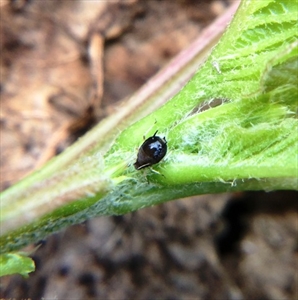- Worldwide distribution. Common among Pacific island countries on food legumes.
- Nymphs slate grey, adults shiny brown or black. In tropics, young born alive. Overcrowding produces winged adults. Spread on the wing and on wind currents.
- Damage severe if infestations early: (i) directly by sap-sucking adults and nymphs damaging shoots, pods and causing stunting (toxins are produced) or wilting, or (ii) indirectly spreading (more than 30) viruses and production of honeydew attracting sooty moulds.
- Natural enemies: ladybird beetles, lacewings, hoverflies; parasitoid wasps, e.g., Trioxys indicus.
- Cultural control: avoid planting next to, or down-wind from infested crops; weed (especially wild legume hosts); remove infested leaves; destroy ant colonies with boiling water (or insecticides); collect and destroy debris after harvest.
- Chemical control: (i) PDPs (derris, chilli, garlic, neem, pyrethrum); (ii) soap solution, horticultural or white oils (see Fact Sheet no. 56). Preserve natural enemies, avoid broad-spectrum insecticides. Only use e.g., synthetic pyrethroids to kill ants.





